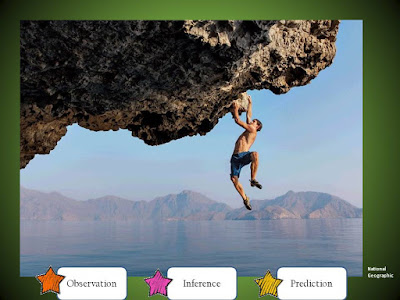What's going on in the picture?
She has a smile on her face but she looks like she's in trouble.
Why do you think that?
Well, her clothes are ragged and she has a black eye. Maybe she got into a fight.
Where is she?
Making Inferences from Pictures
Why do you think she's sitting outside the principal's office?
Making inferences from text is tough for many students. But it's easier if you start inferencing with pictures.
After they tell you what they see, have them infer. What inferences can they make from this picture? It's great to start as a whole class activity because your students will pick up on details together, which will help them infer. Encourage them to use the sentence stems to get thinking started.Then ask them to make a prediction: what do they think is going to happen next?
My students and I look at more pictures to teach inference. Later, we move into small groups or partner work to answer the three questions: What do you observe? What do you infer? What do you predict?
Wait! Did she get into trouble? But she's kind of happy that she did? Like maybe she beat up a bully who was picking on other kids? And she's going to get into trouble for it, but she's still happy that she did it?
I think you might be on to something!
Making Inferences from Pictures with Text
I like to use this picture book for teaching inferencing - The Sweetest Fig by Chris Van Allsburg because there's a twist that many students don't see coming.
Making Inferences from Text Alone
I created a scaffolded version of Briar Rose (Sleeping Beauty) with sentences underlined and question stems to help guide students. Use this with your students after you use picture books so that they can practice this skill with you nearby.
In the end, students make inferences from books they're reading at their independent reading level. That helps you see where any gaps might be.
This takes a few days but the payoff is worth it!
- Want to teach these skills with everything already created for you?
- There's also a version for grades 2-4.






.png)


No comments
Post a Comment